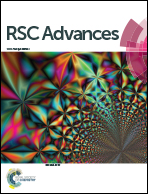Spheres-on-sphere silica microspheres as matrix for horseradish peroxidase immobilization and detection of hydrogen peroxide†
Abstract
In this work, spheres-on-sphere (SOS) silica microspheres are prepared via a facile one-pot synthesis. After functionalization with carboxyl groups, the carboxylated SOS silica microspheres (SOS-COOH microspheres) can serve as a support for horseradish peroxidase (HRP) covalent immobilization. The obtained enzyme hybrid (SOS-COOH-HRP) is more stable under alkaline conditions than the free counterpart, and exhibits longer-term storage stability and higher resistance toward the denaturing agents such as guanidine hydrochloride (GdmCl) and urea. The Michaelis–Menten constant (Km) of the immobilized enzyme is decreased slightly while the maximum rate of reaction (Vmax) is very close to that of free HRP, resulting in the catalytic efficiency of SOS-COOH-HRP being enhanced significantly. For evaluating its utility, a SOS-COOH-HRP-based colorimetric method has been developed for selectively and sensitively detecting H2O2 both in buffer and 10% diluted human serum. Furthermore, the SOS-COOH-HRP displays excellent reusability and reproducibility in cycle analysis. The results demonstrate that the SOS-COOH-HRP has great potential for practical applications in biosensing and industrial fields.


 Please wait while we load your content...
Please wait while we load your content...